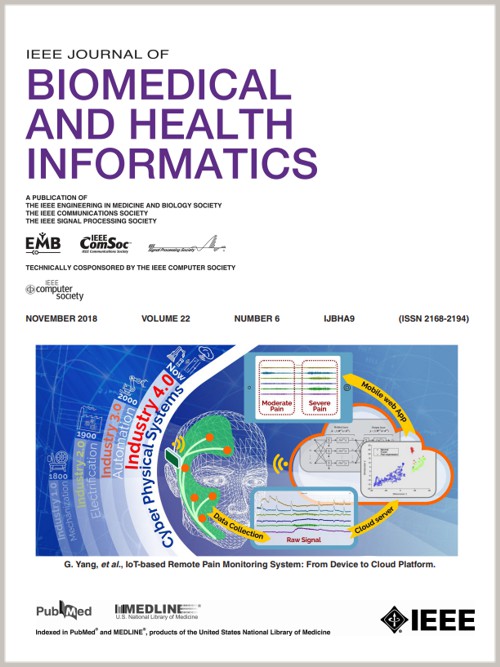Continuous Prediction of Wrist Joint Kinematics Using Surface Electromyography From the Perspective of Muscle Anatomy and Muscle Synergy Feature Extraction
IF 6.7
2区 医学
Q1 COMPUTER SCIENCE, INFORMATION SYSTEMS
IEEE Journal of Biomedical and Health Informatics
Pub Date : 2024-10-22
DOI:10.1109/JBHI.2024.3484994
引用次数: 0
Abstract
Post-stroke upper limb dysfunction severely impacts patients' daily life quality. Utilizing sEMG signals to predict patients' motion intentions enables more effective rehabilitation by precisely adjusting the assistance level of rehabilitation robots. Employing the muscle synergy (MS) features can establish more accurate and robust mappings between sEMG and motion intentions. However, traditional matrix factorization algorithms based on blind source separation still exhibit certain limitations in extracting MS features. This paper proposes four deep learning models to extract MS features from four distinct perspectives: spatiotemporal convolutional kernels, compression and reconstruction of sEMG, graph topological structure, and the anatomy of target muscles. Among these models, the one based on 3DCNN predicts motion intentions from the muscle anatomy perspective for the first time. It reconstructs 1D sEMG samples collected at each time point into 2D sEMG frames based on the anatomical distribution of target muscles and sEMG electrode placement. These 2D frames are then stacked as video segments and input into 3DCNN for MS feature extraction. Experimental results on both our wrist motion dataset and public Ninapro DB2 dataset demonstrate that the proposed 3DCNN model outperforms other models in terms of prediction accuracy, robustness, training efficiency, and MS feature extraction for continuous prediction of wrist flexion/extension angles. Specifically, the average nRMSE and R 2 values of 3DCNN on these two datasets are (0.14/0.93) and (0.04/0.95), respectively. Furthermore, compared to existing studies, the 3DCNN outperforms musculoskeletal models based on direct collocation optimization, physics-informed GANs, and CNN-LSTM-based deep Kalman filter models when evaluated on our dataset.从肌肉解剖学和肌肉协同特征提取的角度,利用表面肌电图连续预测腕关节运动学。
中风后上肢功能障碍严重影响患者的日常生活质量。利用 sEMG 信号来预测患者的运动意图,可以精确调整康复机器人的辅助水平,从而实现更有效的康复。利用肌肉协同(MS)特征可以在 sEMG 和运动意图之间建立更准确、更稳健的映射。然而,基于盲源分离的传统矩阵因式分解算法在提取 MS 特征时仍存在一定的局限性。本文提出了四种深度学习模型,分别从时空卷积核、sEMG 压缩与重构、图拓扑结构和目标肌肉解剖四个不同角度提取 MS 特征。在这些模型中,基于 3DCNN 的模型首次从肌肉解剖学角度预测了运动意图。它根据目标肌肉的解剖分布和 sEMG 电极位置,将每个时间点采集的 1D sEMG 样本重构为 2D sEMG 帧。然后将这些 2D 帧堆叠为视频片段,输入 3DCNN 进行 MS 特征提取。在我们的手腕运动数据集和公开的 Ninapro DB2 数据集上的实验结果表明,在连续预测手腕屈伸角度方面,所提出的 3DCNN 模型在预测准确性、鲁棒性、训练效率和 MS 特征提取方面都优于其他模型。具体来说,3DCNN 在这两个数据集上的平均 nRMSE 和 R2 值分别为 (0.14/0.93) 和 (0.04/0.95)。此外,与现有研究相比,在我们的数据集上评估时,3DCNN 优于基于直接定位优化的肌肉骨骼模型、物理信息 GAN 和基于 CNN-LSTM 的深度卡尔曼滤波模型。
本文章由计算机程序翻译,如有差异,请以英文原文为准。
求助全文
约1分钟内获得全文
求助全文
来源期刊

IEEE Journal of Biomedical and Health Informatics
COMPUTER SCIENCE, INFORMATION SYSTEMS-COMPUTER SCIENCE, INTERDISCIPLINARY APPLICATIONS
CiteScore
13.60
自引率
6.50%
发文量
1151
期刊介绍:
IEEE Journal of Biomedical and Health Informatics publishes original papers presenting recent advances where information and communication technologies intersect with health, healthcare, life sciences, and biomedicine. Topics include acquisition, transmission, storage, retrieval, management, and analysis of biomedical and health information. The journal covers applications of information technologies in healthcare, patient monitoring, preventive care, early disease diagnosis, therapy discovery, and personalized treatment protocols. It explores electronic medical and health records, clinical information systems, decision support systems, medical and biological imaging informatics, wearable systems, body area/sensor networks, and more. Integration-related topics like interoperability, evidence-based medicine, and secure patient data are also addressed.
 求助内容:
求助内容: 应助结果提醒方式:
应助结果提醒方式:


